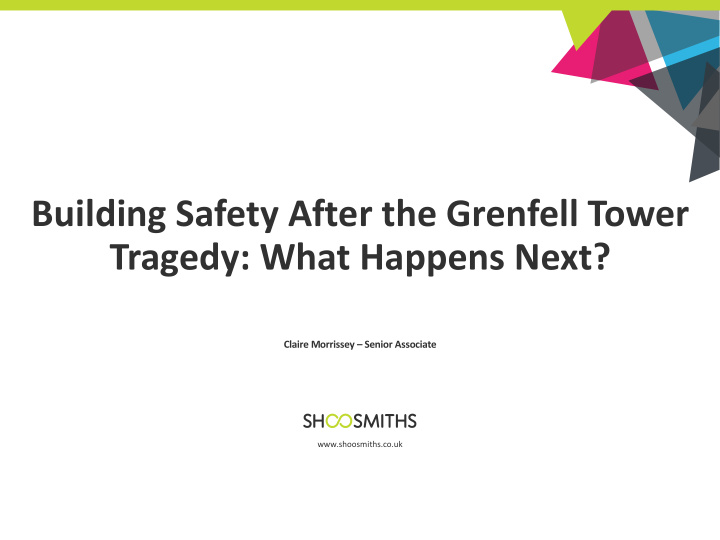



Building Safety After the Grenfell Tower Tragedy: What Happens Next? Claire Morrissey – Senior Associate www.shoosmiths.co.uk
Grenfell Tower § 72 deaths § 70 more injured § Largest loss of life in a residential property since WW2 § Lakanal House warnings § The Public Inquiry § List of Issues § What have we learnt so far? § What is still to come?
Building a safer future • Former Head of the HSE, Dame Judith Hackitt was tasked with undertaking a review of fire safety and building regulations in the UK. • Issues included: lack of engagement with the guidance and legislation, lack of regulatory oversight, lack of real enforcement threat/penalties, race to the bottom on fees. • Recommendations included : new regulatory framework (clarifying roles and responsibilities), new joint regulator and working on giving residents more of a voice.
PHASE 1 REPORT • October 2019 • Recommendations addressed: • Use of combustible materials • Testing and certification of materials • Plans – internal layout • Lifts • Sprinkler systems • Fire doors
Building (amendment) Regulations 2018 • Came into force 21 st December 2018 • Applies only to relevant buildings • Building height 18 metres • Requirement that: “…materials which become part of an external wall, or specified attachment, of a relevant building are of European Classification A2-s1, d0 or A1.” • Material change of use: “…any external wall, or specified attachment, of the building only contains materials of European Classification A2-s1, d0 or A1.”
Building safety programme • MCHLG led programme • Currently consulting on extending cladding ban including lowering the 18 metres threshold to 11 metres • Independent Expert Advisory Panel established to: “recommend to the government any immediate action it thinks that the government should take that will improve public safety and help to identify buildings of concern.” • Advice for Building Owners of Mutli-storey, Multi- occupied Residential Buildings • ACM and unsafe non-ACM cladding • New clarified Approved Document B 2019
Industry response group • Competency Steering Group • Set up by the IRG to “tackle competency failings” • Raising the Bar – Interim Report August 2019 • Proposes “radical and wide-ranging” measures which aim to improve competence in design, construction, inspection, maintenance and operation of high risk residential buildings (“HRRBs”). • 67 recomm endations • Building Safety Competency Committee • Individuals working on HRRBs to be registered/certified • Building Safety Regulator Register
Working group 8 building safety co-ordinator • Independent Review of Building Regulations and Fire Safety: Final Report - February 2019 • Role of the Building Safety Co-Ordinator • Bringing in core behaviours to deliver culture change • Extending the roll of the Building Safety Co- Ordinator to other building types • Golden Thread of information • Licensing and Building classification • Resident voice and engagement • Delivering competency
The Fire safety bill • First reading 19 th March 2020 • Extending remit of the RRFSO 2005 • Will include multi-occupied domestic residential premises • Will require the responsible person to take into account the structure and external walls of the building and fire doors • Undertake a RA to identify the risk to the safety of persons from fire • Regular lift inspections with findings summarised in monthly reports to local fire and rescue service • Implementation and regular review of evacuation plans
What’s next? • Phase 2 of the Public Inquiry • Will consider questions about the adequacy of Building Regulations at the time of the refurbishment • Other active and passive fire safety measures • Materials testing • The role of the parties involved in the refurbishment including Building Control • The Building Safety Bill • Announced in Queen’s Speech December 2019 • The Building Safety Regulator
HOW to GET ahead (1) The Golden Thread of Information • Do you/your clients have correct and up to date information about buildings and is it saved in electronic format? • What is the hazard profile of the building? • Where are the records, plans and schematics kept? • Is there a gap in any of the information? • How does building information align with the management of health and safety within the building? • Asbestos? • Legionella? • Movement of vehicles?
How to get ahead (2) Build Competency • Developing the role of the Building Safety Co-Ordinator • Competency and qualifications – the competency framework • Leading and delivering safety • Understanding building systems and operations • Demonstrating control • How will it work in practice? • How will works undertaken by third parties be signed off, monitored and/or supervised?
How to get ahead (3) Fire Safety • Increase involvement in the fire risk assessment process • Do you understand what the FRA says? • Is the FRA as detailed as it needs to be? • Assisting to close out remedial actions • What documentation do you need to collate to create a Fire and Emergency File (“FEF”) ? • How will the review of the FEF be managed? • What about works carried out at the building which might have an effect on the fire and emergency arrangements?
How to get ahead (4) Building Relationships with the LFA • What kind of relationship do you/your clients have with local fire and emergency services? • What information do they have about your buildings at the moment? • Do they need to be told about anything specific? • Unusual access routes • Specific building materials • Access to risers • First aid arrangements
ANY questions?
Get in Touch Claire.Morrissey@shoosmiths.co.uk 03700 86 4189 UK direct dial Claire Morrissey +44 (0) 7889306035 Mobile Shoosmiths LLP
Recommend
More recommend